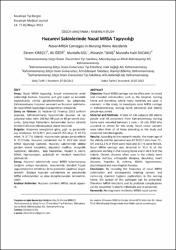Huzurevi sakinlerinde nazal MRSA taşıyıcılığı
Özet
Amaç: Nazal MRSA taşıyıcılığı, birçok malzemenin ortak
kullanıldığı hastane, huzurevi, yurt gibi kapalı ve kalabalık
topluluklarda sıklıkla görülebilmektedir. Bu çalışmada,
Kahramanmaraş huzurevi personeli ve huzurevi sakinlerinde
nazal MRSA taşıyıcılığının araştırılması amaçlandı.
Gereç ve Yöntem: 01 Haziran–10 Temmuz 2010 tarihleri
arasında, Kahramanmaraş huzurevinde bulunan ve bu
çalışmayı kabul eden 146 kişi (98 yaşlı ve 48 personel) oluş-
turdu. Çalışmaya katılanların tamamından burun sürüntü
örnekleri alınarak mikrobiyolojik olarak incelendi.
Bulgular: Araştırma sonuçlarına göre, yaşlı ve personelin
yaş ortalaması 62.5±20.7 (min-max:22–97) olup, % 62.3’ü
erkek, % 37.7’si kadındı. Huzurevinde çalışan personellerin
% 33.3’ünde, huzurevi sakinlerinin ise % 40.8’inde nazal
MRSA taşıyıcılığı saptandı. Huzurevi sakinlerinde sıklıkla
görülen kronik hastalıklar, diyabetes mellitus, ortopedik
hastalıklar, dekübitis, kalp hastalıkları, hepatit B, astım,
KOAH, hipertansiyon, psikolojik ve nörolojik hastalıklar
şeklinde idi.
Sonuç: Huzurevi sakinlerinde nazal MRSA kolonizasyonu
sıklığının ortaya konularak, huzurevinde standart hijyen
uygulamalarının artırılması ile bu patojenin yayılması engellenebilir.
Böylece huzurevi sakinlerinde ve personelde
MRSA enfeksiyonları ve olası komplikasyonları önlenebilecektir. Objective: Nasal MRSA carriage can be often seen in closed
and crowded communities such as the hospital, nursing
home and dormitory where many materials are used in
common. In this study, to investigate nasal MRSA carriage
in Kahramanmaraş nursing home personnel and elderly
people was aimed.
Material and Methods: A total of 146 subjects (98 elderly
people and 48 personnel) from Kahramanmaraş nursing
home were recruited between 1 June – 10 July 2010 who
accepted to attend for this study. Nasal smear samples
were taken from all of those attending to the study and
examined microbiologically.
Results: According to the research results, the mean age of
the elderly and the personnel was 62.5±20.7 (min-max: 22–
97) and 62.3 % of them were male and 37.7 % were female.
Nasal MRSA carriage was detected in 33.3 % of the
personnel working in the nursing home and in 40.8 % of the
elderly. Chronic diseases often seen in the elderly were
diabetes mellitus, orthopedic diseases, decubitus, heart
diseases, hepatitis B, asthma, KOAH, hypertension,
psychological and neurological diseases.
Conclusion: By revealing the frequency of nasal MRSA
colonization and consequently treating carriers and
increasing standard hygiene applications in the nursing
home, the spread of this pathogen can be prevented.
Therefore MRSA infections and its probable complications
can be prevented in elderly individuals and in personnel.
Kaynak
Kocatepe Tıp DergisiCilt
14Sayı
2Bağlantı
http://hdl.handle.net/11630/2021Koleksiyonlar
- Makaleler [452]



















